 W
WThe Early Dynastic period is an archaeological culture in Mesopotamia that is generally dated to c. 2900–2350 BC and was preceded by the Uruk and Jemdet Nasr periods. It saw the development of writing and the formation of the first cities and states. The ED itself was characterized by the existence of multiple city-states: small states with a relatively simple structure that developed and solidified over time. This development ultimately led to the unification of much of Mesopotamia under the rule of Sargon, the first monarch of the Akkadian Empire. Despite this political fragmentation, the ED city-states shared a relatively homogeneous material culture. Sumerian cities such as Uruk, Ur, Lagash, Umma, and Nippur located in Lower Mesopotamia were very powerful and influential. To the north and west stretched states centered on cities such as Kish, Mari, Nagar, and Ebla.
 W
WSumer is the earliest known civilization in the historical region of southern Mesopotamia, emerging during the Chalcolithic and early Bronze Ages between the sixth and fifth millennium BC. It is also one of the first civilizations in the world, along with Ancient Egypt, Norte Chico, the Minoan civilization, and the Indus Valley Civilization. Living along the valleys of the Tigris and Euphrates, Sumerian farmers grew an abundance of grain and other crops, the surplus from which enabled them to form urban settlements. Proto-writing dates back before 3000 BC. The earliest texts come from the cities of Uruk and Jemdet Nasr, and date to between c. 3500 and c. 3000 BC.
 W
WThe Abzu or Apsu, also called engur, is the name for fresh water from underground aquifers which was given a religious fertilising quality in Sumerian and Akkadian mythology. Lakes, springs, rivers, wells, and other sources of fresh water were thought to draw their water from the abzu. In this respect, in Sumerian and Akkadian mythology it referred to the primeval sea below the void space of the underworld (Kur) and the earth (Ma) above.
 W
WAncient Mesopotamian units of measurement originated in the loosely organized city-states of Early Dynastic Sumer. Each city, kingdom and trade guild had its own standards until the formation of the Akkadian Empire when Sargon of Akkad issued a common standard. This standard was improved by Naram-Sin, but fell into disuse after the Akkadian Empire dissolved. The standard of Naram-Sin was readopted in the Ur III period by the Nanše Hymn which reduced a plethora of multiple standards to a few agreed upon common groupings. Successors to Sumerian civilization including the Babylonians, Assyrians, and Persians continued to use these groupings. Akkado-Sumerian metrology has been reconstructed by applying statistical methods to compare Sumerian architecture, architectural plans, and issued official standards such as Statue B of Gudea and the bronze cubit of Nippur.
 W
WThe Code of Ur-Nammu is the oldest known law code surviving today. It is from Mesopotamia and is written on tablets, in the Sumerian language c. 2100–2050 BCE.
 W
WDilmun, or Telmun, was an ancient Semitic-speaking polity in Arabia mentioned from the 3rd millennium BC onwards. Based on contextual evidence, it was located in the Persian Gulf, on a trade route between Mesopotamia and the Indus Valley Civilisation, close to the sea and to artesian springs. A number of scholars have suggested that Dilmun originally designated the eastern province of Saudi Arabia, notably linked with the major Dilmunite settlements of Umm an-Nussi and Umm ar-Ramadh in the interior and Tarout on the coast. Dilmun encompassed Bahrain, Kuwait, Qatar and the eastern portion regions of Saudi Arabia. This area is certainly what is meant by references to "Dilmun" among the lands conquered by King Sargon of Akkad and his descendants.
 W
WThe Dynasty of Isin refers to the final ruling dynasty listed on the Sumerian King List (SKL). The list of the Kings Isin with the length of their reigns, also appears on a cuneiform document listing the kings of Ur and Isin, the List of Reigns of Kings of Ur and Isin.
 W
WEdubba (Sumerian: 𒂍𒁾𒁀𒀀 E2-DUB-ba-a) is the Sumerian for "scribal school." The eduba was the institution that trained and educated young scribes in ancient Mesopotamia during the late third or early second millennium BCE. Most of the information known about edubas comes from cuneiform texts dating to the Old Babylonian period (ca. 2000-1600 BCE).
 W
WGu-Edin was a fertile plain in Sumer, in modern-day Iraq. It lay between Umma and Lagash, and claims made on it by each side were a cause of war. Argument over the territory continued for around 150 years.
 W
WThe Gutian dynasty, also Kuti or Kutians was a dynasty that came to power in Mesopotamia c. 2199—2119 BC (middle), or possibly c. 2135—2055 BC (short), after displacing the Akkadian Empire. It ruled for roughly one century; however, some copies of the Sumerian King List (SKL) vary between 4 and 25 years. The end of the Gutian dynasty is marked by the accession of Ur-Nammu.
 W
WThe history of Sumer, taken to include the prehistoric Ubaid and Uruk periods, spans the 5th to 3rd millennia BCE, ending with the downfall of the Third Dynasty of Ur around 2004 BCE, followed by a transitional period of Amorite states before the rise of Babylonia in the 18th century BCE.
 W
WThe Isin-Larsa period is a phase in the history of ancient Mesopotamia, which extends between the end of the Third Dynasty of Ur and the conquest of Mesopotamia by King Hammurabi of Babylon leading to the creation of the First Babylonian dynasty. According to the approximate conventional dating, this period begins in 2025 BCE and ended in 1763 BCE. It constitutes the first part of the Old Babylonian period, the second part being the period of domination of the first dynasty of Babylon, which ends with the Sack of Babylon in 1595 BCE and the rise of the Kassites.
 W
WA kaunakes or persis was a woolen mantle associated with ancient Mesopotamia and Persia. It was woven in a tufted pattern suggesting overlapping petals or feathers, either by sewing tufts onto the garment or by weaving loops into the fabric.
 W
WKing of Sumer and Akkad was a royal title in Ancient Mesopotamia combining the titles of "King of Akkad", the ruling title held by the monarchs of the Akkadian Empire with the title of "King of Sumer". The title simultaneously laid a claim on the legacy and glory of the ancient empire that had been founded by Sargon of Akkad and expressed a claim to rule the entirety of lower Mesopotamia. Despite both of the titles "King of Sumer" and "King of Akkad" having been used by the Akkadian kings, the title was not introduced in its combined form until the reign of the Neo-Sumerian king Ur-Nammu, who created it in an effort to unify the southern and northern parts of lower Mesopotamia under his rule. The older Akkadian kings themselves might have been against linking Sumer and Akkad in such a way.
 W
WKing of the Four Corners of the World, alternatively translated as King of the Four Quarters of the World, King of the Heaven's Four Corners or King of the Four Corners of the Universe and often shortened to simply King of the Four Corners, was a title of great prestige claimed by powerful monarchs in ancient Mesopotamia. Though the term "four corners of the world" does refer to specific geographical places within and near Mesopotamia itself, these places were at the time the title was first used thought to represent locations near the actual edges of the world and as such, the title should be interpreted as something equivalent to "King of all the known world", a claim to universal rule over the entire world and everything within it.
 W
WKing of the Universe, also interpreted as King of Everything, King of the Totality, King of All or King of the World, was a title of great prestige claiming world domination used by powerful monarchs in ancient Mesopotamia. The title is sometimes applied to God in the Judeo-Christian and Abrahamic tradition.
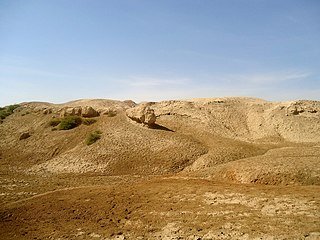 W
WThe Kish civilization or Kish tradition is a time period corresponding to the early East Semitic era in Mesopotamia and the Levant. Coined by Ignace Gelb, the epoch began in the early 4th millennium BC. The tradition encompasses the sites of Ebla and Mari in the Levant, Nagar in the north, and the proto-Akkadian sites of Abu Salabikh and Kish in central Mesopotamia which constituted the Uri region as it was known to the Sumerians. The East Semitic population migrated from what is now the Levant and spread into Mesopotamia, and the new population could have contributed to the collapse of the Uruk period c. 3100 BC. This early East Semitic culture is characterized by linguistic, literary and orthographic similarities extending from Ebla in the west to Abu Salabikh in the East. The personal names from the Sumerian city of Kish show an East Semitic nature and reveals that the city population had a strong Semitic component from the dawn of recorded history, Gelb consider Kish to be the center of this civilization, hence the naming.
 W
WMa is a Sumerian word meaning "land" that in Sumerian mythology was also used to regard Primordial Land.
 W
WMeluḫḫa or Melukhkha is the Sumerian name of a prominent trading partner of Sumer during the Middle Bronze Age. Its identification remains an open question, but most scholars associate it with the Indus Valley Civilization.
 W
WMiscellaneous Babylonian Inscriptions is a 1918, Sumerian linguistics and mythology book written by George Aaron Barton.
 W
WThe Royal Game of Ur, also known as the Game of Twenty Squares or simply the Game of Ur, is a two-player strategy race board game that was first played in ancient Mesopotamia during the early third millennium BC. The game was popular across the Middle East among people of all social strata and boards for playing it have been found at locations as far away from Mesopotamia as Crete and Sri Lanka. At the height of its popularity, the game acquired spiritual significance, and events in the game were believed to reflect a player's future and convey messages from deities or other supernatural beings. The Game of Ur remained popular until late antiquity, when it stopped being played, possibly evolving into, or being displaced by, an early form of backgammon. It was eventually forgotten everywhere except among the Jewish population of the Indian city of Kochi, who continued playing a version of it until the 1950s when they began emigrating to Israel.
 W
WSharur, which means "smasher of thousands" is the weapon and symbol of the god Ninurta. Sumerian mythic sources describe it as an enchanted talking mace. It has been suggested as a possible precursor for similar objects in other mythology such as Arthurian lore.
 W
WShin Shifra ; is the pen name of Shifra Shifman Shmuelevitch, a poet, translator, writer, editor and literary academic. Shifra won multiple literature awards.
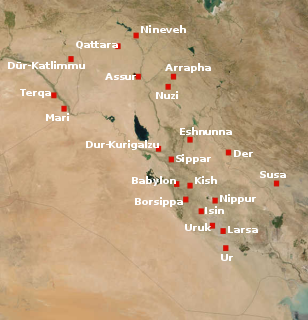 W
WShinar is the southern region of Mesopotamia in the Hebrew Bible.
 W
WSumerian Farmer's Almanac is the first farmer's almanac on record. The farmer's almanac is dated to around 1700 to 1500 BCE. It was discovered in 1949 by an American expedition in Iraq sponsored jointly by the Oriental Institute of the University of Chicago and the University Museum of the University of Pennsylvania.
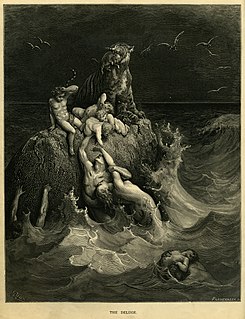 W
WA flood myth or deluge myth is a myth in which a great flood, usually sent by a deity or deities, destroys civilization, often in an act of divine retribution. Parallels are often drawn between the flood waters of these myths and the primaeval waters which appear in certain creation myths, as the flood waters are described as a measure for the cleansing of humanity, in preparation for rebirth. Most flood myths also contain a culture hero, who "represents the human craving for life".
 W
WSumerian is the language of ancient Sumer and a language isolate that was spoken in Mesopotamia, in the ancient Fertile Crescent. During the 3rd millennium BC, an intimate cultural symbiosis developed between the Sumerians and the Semitic-speaking Akkadians, which included widespread bilingualism. The influence of Sumerian and the East Semitic language Akkadian on each other is evident in all areas, from lexical borrowing on a substantial scale to syntactic, morphological, and phonological convergence. This has prompted scholars to refer to Sumerian and Akkadian in the third millennium BC as a Sprachbund.
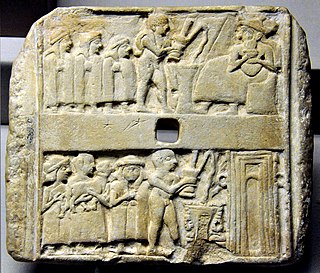 W
WSumerian religion was the religion practiced and adhered to by the people of Sumer, the first literate civilization of ancient Mesopotamia. The Sumerians regarded their divinities as responsible for all matters pertaining to the natural and social orders.
 W
WBala, Sumerian for "exchange", is the method by which the Ur III dynasty of Mesopotamia collected goods such as livestock, grain, labor and craft products from its provinces. Individuals of all rank were expected to contribute to this system. These taxes were used to fund building projects within the kingdom such as the building of canals which were vital in this area because the agriculture in this area was irrigated by water from the Tigris and Euphrates rivers. Those projects were built by Gurush/Geme (Sumerian), men and women workers respectively, paid using goods collected from the tax system. The provinces in the Ur III Empire such as Girsu, Umma and Lagash contributed materials according to the nature of goods they produced, their size and the amount of goods they could produce. For instance Girsu was a rich source of grain and would provide grain to the bala system whereas Umma was a source of other goods such as leather, reed, and wood. The central state also provided protection to the provinces as a means of protecting the resources while in transit as well as the cities from being overrun by raiders.
 W
WThe Third Dynasty of Ur, also called the Neo-Sumerian Empire, refers to a 22nd to 21st century BC Sumerian ruling dynasty based in the city of Ur and a short-lived territorial-political state which some historians consider to have been a nascent empire.
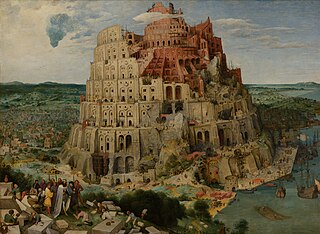 W
WThe Tower of Babel is a narrative found in the Book of Genesis in the Old Testament and Hebrew Bible. The narrative is an origin myth meant to explain why the world's peoples speak different languages.
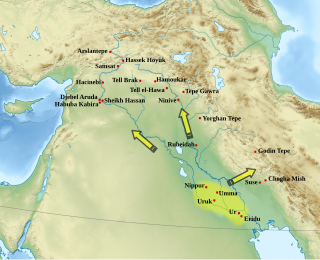 W
WThe Uruk period existed from the protohistoric Chalcolithic to Early Bronze Age period in the history of Mesopotamia, after the Ubaid period and before the Jemdet Nasr period. Named after the Sumerian city of Uruk, this period saw the emergence of urban life in Mesopotamia and the Sumerian civilization. The late Uruk period saw the gradual emergence of the cuneiform script and corresponds to the Early Bronze Age; it has also been described as the "Protoliterate period".